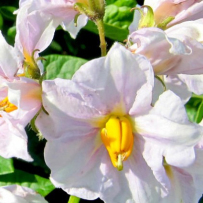Nandina
Sort characteristics
- Maturing rate:
super-early ; - Tuber shape: oval;
- Eyeholes bedding depth: small;
- Pulp color: yellow;
- Jacket properties: smooth;
- Cooking properties: C, the texture is mainly solid. Early nutritious matter accumulation. Pulp color: clean, yellow and it doesn’t get dark after boiling.
Stability:
- Nematode: Ro 1
- Potato wart disease: yes
- Virus: high stability
- Scab: moderate to high stability
- Potato blight: medium to high stability
- Stability of the pulp to impacts: high
- Stability to mechanical damage: high
Recommendations on planting:
The Nandina potato is the groundbreaker among the table potato sorts.
This seed potato sort raises medium to high demands to the ground and moisture. It is highly recommended to plant it into well-cultivated grounds. In case of early harvesting or planting the potato under a tent greensprouting is recommended which will also contribute into early tuber maturing.
Special instructions:
The Nandina sort forms a moderate to large number of tubers in a hole so the potato shall be planted with the
This sort is responsive to systematic fertilization. The Nandina sort is referred to the new type of potato with decreased needs in nitrogen. The general (gross) nitrogen value: up to 160kg/hectare (considering the Nmin, organic fertilizers ± correction depending on the peculiarities of the particular region). Together with the Ê2Î (200–250 kg/hectare, C class) and P2O5 (100 kg/hectare, C class) it is necessary to consider the availability of magnesium in the potato. It is also necessary to consider the afterharvesting residues and organic fertilizers.
Systematic





